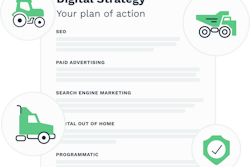
Growing sales doesn’t always grow your bottom line. Dr. Al Bates with the Performance Distribution Project says you might have already known that.
But during a Trucks, Parts, Service webinar sponsored by Fullbay on Thursday, Bates shared how all too often businesses look at sales as their only path to prosperity and overlook the impact gross margin and expenses can have on company’s profitability. Bates says adding sales and revenue is great — it’s what every business owner should want to do. But it can’t be your sole focus.
What’s happening inside your operation is just as important as outside, if not more so, Bates says, and businesses that fail to maximize margins and control internal expenditures can sometimes see their profits before taxes fall even as top-line sales continue to increase.
[RELATED: Did you miss Thursday’s webinar? You can watch in on demand here]
“Driving higher profit requires focusing on the right things,” says Bates. “Gross margin is the biggest driver of profitability for your business. For every business. Expenses are number two and sales are third.”
In Thursday’s webinar, Bates visualized his belief with an example.

“Your sales growth is important but it’s not the driver of profitability. Sales growth by itself doesn’t mean doodley freaking scott,” Bates says.
Bates spent the rest of his presentation zeroing in on margins and expenses. On the former, Bates says gross margin can be grown by lowering purchase expenses or raising prices. Both work but raising prices has a larger bottom-line impact because sales is a bigger number than cost of goods sold, he says.
“Buying it cheaper is nifty. Selling it for higher is niftier,” Bates jokes.
But how can a parts and service shop raise prices in a competitive marketplace?
[RELATED: Good news hard to find in second-quarter TPS MarketPulse survey]
Bates says don’t tinker with your highest volume parts. You might as well put up a sign on the highway that says you’re more expensive than competitors. It’s in the slow-moving (but often needed immediately) class D movers where Bates says prices should shift. Those are the “blind items,” he says, where nobody really knows how much a product should cost and thus are willing to pay any price to acquire it.
As for expenses, Bates doesn’t advocate for cutting workers or services. He says most expenses, such as salaries, are fixed and thus don’t change unless you change them. Bates says maintaining a healthy sales to payroll gap — where the former rises annually at a higher percentage than the latter — will drive down expenses without forcing a workforce reduction.
Finally, Bates says when committing to bottom-line improvement strategy, it’s important to be realistic with your timelines. He says trying to go from 3 to 6% profit before taxes can be done, but not in a year.
“Doubling profit is a realistic goal, but over a time frame,” he says.
For more from Bates' Distribution Performance Project, go to the company website or email him at [email protected].












